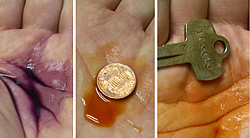Press release October 20th, 2006
"Money does not smell – until it is touched"
Scientists explain the typical odor of iron and other metals
Leipzig/Blacksburg(USA). The typical metallic odor from touching iron containing coins, tools and other metal items is not caused by metal vapor, but by
organic molecules from human skin. For this kind of human body odor, the iron (similar to copper) is acting only as a catalyst of the decomposition and
evaporation of odor-intensive organic skin compounds.
Another known ”garlic” odor of pickling phosphorus containing cast iron and steel with acids is not caused by phosphorus hydride (phosphine) but by
organophosphor-compounds.

"Pecunia non olet" (Money does not smell)
Source: Dr. Dietmar Glindemann

Color-tests of iron powder, copper penny, brass key
Foto: Dr. Dietmar Glindemann
A German-American research team led by chemist Dietmar Glindemann was able to prove these fallacies wrong. These research results under participation of scientists of Virginia Polytechnic Institute and State University (Virginia Tech), the University of Leipzig, and the Centre for Environmental Research Leipzig-Halle (UFZ) are now published by the highly rated science magazine ”Angewandte Chemie International Edition“.
Iron causes ”metallic“ human body odor
Of all the human senses, odor has been the most difficult to scientifically explain. Only two years ago, Linda Buck and Richard Axel were awarded the Nobel Prize in Medicine for being the first to decipher the more than 1000 genes that determine the sense of smell. Scientists from Blacksburg (VA, USA) und Leipzig are now working to unravel the equally complex chemistry of smell. “We are the first to demonstrate that when humans describe the “metallic” odor of iron metal, it is not evaporated iron atoms that smell. The odors humans perceive as “metallic” when they touch iron are really volatilized compounds of skin” said Prof. Andrea Dietrich from Virgina Tech. These odorous aldehydes and ketones split off of a kind of rancid skin fat (lipidperoxides) due to their decomposition by “bivalent” iron ions. This reactive form of iron (also called green rust) is a result of partial dissolution (corrosion) of the iron metal with acidic sweat from the skin. Since skin fat sticks to metal surfaces, a coin or a door handle containing iron or copper will smell via the decomposed lipidperoxides from all the human users that have previously touched them.
From iron odor to blood scent – on a track back to prehistoric times
The researchers also showed that the same iron odor is produced when blood is rubbed on skin, since fresh blood contains “bivalent” iron. They concluded that the very distinct human sense for ”iron odor“ is akin to the sensitive sense of animals and humans for ”blood scent“. The ability to smell blood was an evolutionary advantage because it allowed early humans and their animal ancestors to track and find injured and bleeding pray like a “blood trailing” dog.
The different metallic odor of phosphorus-rich iron
The publication of the researchers also provides data about another ”garlic“ metallic odor--that of cast iron or steel that is dissolved in acids. This odor results from the formation of ”organophosphines“ from carbon and phosphorus impurities in the iron. Glindemann is recommending a simple sniff-test to demonstrate these organophosphines: “Filings of cast iron heated in a reagent tube with aquatic hydrochloric acid yield foaming gas bubbles that smell like garlic or calcium carbide. Use cast iron because it contains much phosphorus, is easily dissolved, and smells strongly”. “The difficulty was to maximize the production of these air-sensitive organophosphines from iron in the laboratory, to be able to analyze them safely with sophisticated analytical equipment that was still much less sensitive compared to the human nose” says Dr. Hans-Joachim Stärk from UFZ regarding this analytical challenge. Since these phosphines oxidize quickly in air, they were never before detected in the environment, although high-tech laboratories produce them as semiconductor dopants. The publication also shows that common corrosion of cast iron results in additional organophosphorus compounds that are monitored under the Chemical Weapons Convention (CWC) since they are a “fingerprint” of the production and use of nerve gas. The scientists are afraid that widely abundant organophosphorus corrosion products could lead to confusion in the verification of the CWC.
New applications
”Our research results confirm hints of the human nose that the iron that is widely abundant in our all-day environment is capable of reacting with the human skin, resulting in odorous and reactive organic compounds. It should be investigated whether iron could in this way impact human health“ suggests Glindemann. The scientists want to encourage the medical community to develop an analytical iron assay to measure peroxidation of human skin, blood, and body tissue. Individual body odor, oxidative stress, and a variety of diseases could be identified by their specific chemical ”fingerprint“ of volatile odorants. It was not until recently that news about “cancer sniffing dogs” hit the public. On the other hand, the exploration of the metallic skin odor could help water engineers to explain customer complaints about “metallic odor” of drinking water. The environmental scientists hope that these results can help to find buried metallic and organic waste by tracking their odorous reaction products or to mitigate such odor forming reactions in odorous landfills.
Scientific Publication
Dietmar Glindemann, Andrea Dietrich, Hans-Joachim Staerk und Peter Kuschk:
The Two Smells of Touched or Pickled Iron – (Skin) Carbonyl-Hydrocarbons and Organophosphines
Angewandte Chemie International Edition, Early View
www3.interscience.wiley.com
Additional technical information:
Dr. D. Glindemann / Prof. Dr. A. Dietrich
Virginia Polytechnic Institute and State University
e-mail: dglindem@vt.edu
e-mail: andread@vt.edu
Dr. Hans-Joachim Stärk / Dr. Peter Kuschk
Helmholtz Centre for Environmental Research – UFZ
phone ++49 341 235-2289 / ++49 341 235-2821
or:
Doris Böhme / Tilo Arnhold,br />
Public Relations of Helmholtz Centre for Environmental Research – UFZbr />
Phone: +49-341-235-2278
e-mail: presse@ufz.de
